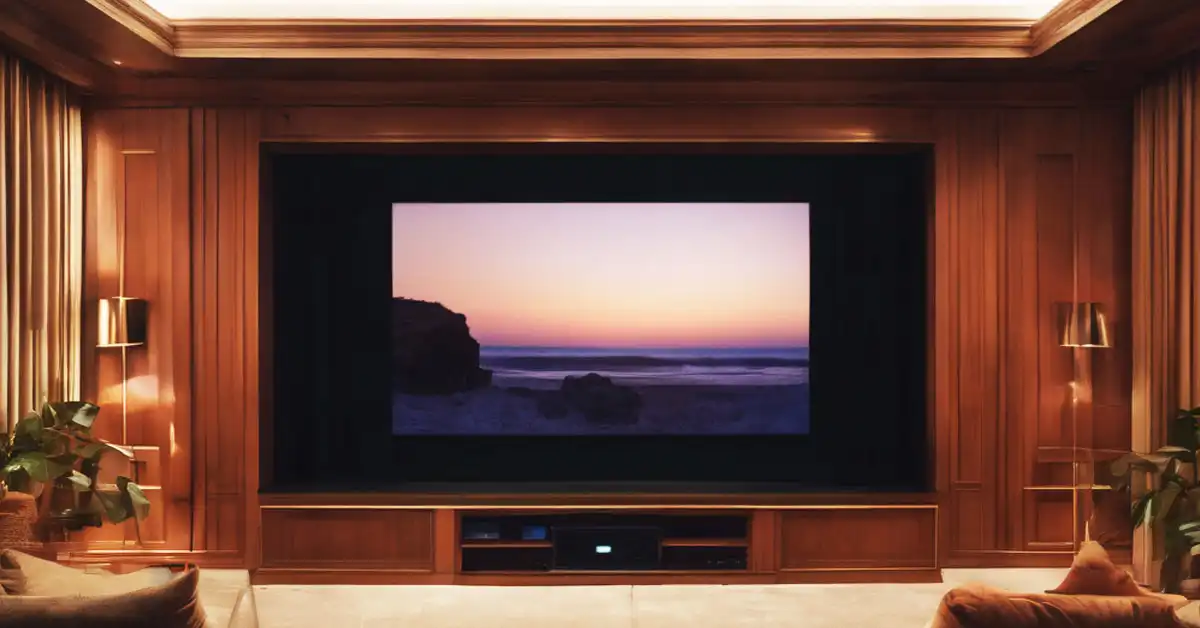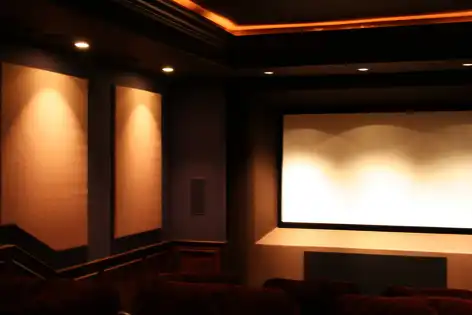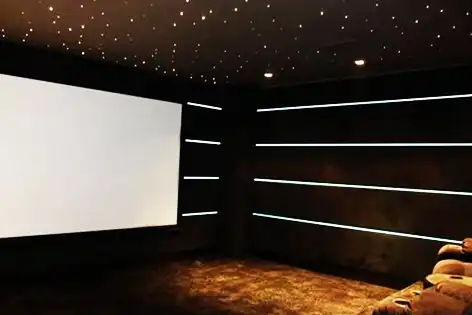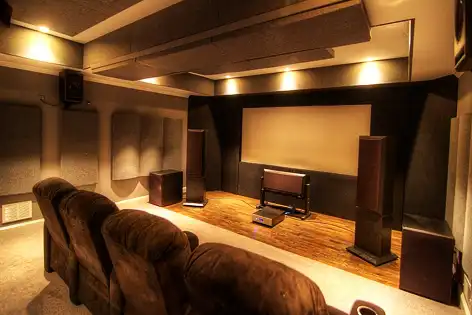Before getting into the specifics of room size and shape, it’s important to know the basics of how to plan a home theater. A well-designed home theater is more than just putting up a big screen and good speakers. It means making a space that makes the sound and video parts of your leisure system better.
The size of your home theater room is very important to how the whole experience goes. If the room is too small, people may have trouble sitting comfortably and the sound quality may be bad. But if the room is too big, it might not feel as intense when you’re surrounded by sound and images.
When you measure the size of the room, you should think about how far away you can see the screen. For a more immersive movie experience, the Society of Motion Picture and Television Engineers (SMPTE) suggests a watching angle of about 30 degrees. This is the same as being 1.5 to 2.5 times the diagonal size of your screen away. So, for a 100-inch screen, the best distance to watch it from is between 12.5 and 20.8 feet.
The form of your home theater room is just as important as its size when it comes to sound quality. Rooms that aren’t perfectly round, with odd angles and uneven sizes, can make it hard to hear because sound can bounce around and get distorted. A room that is rectangular and has walls that are straight will sound the best. This form keeps sound from reflecting too much and makes sure that sound is spread out more evenly in the room.
A lot of attention is usually paid to the sound, but the shape of your room can also affect how your home theater looks. While evaluating the size and shape of a Home Theater, you should carefully plan where to put your screen and how to order your chairs to avoid problems like images that aren’t straight or viewing angles that aren’t wide enough. Every place in the house has a great view of the TV because the room is rectangular, which makes it easy to set up.
Now that we’ve talked about the ideas behind room size and shape, let’s look at how your space actually works. If you’re lucky enough to have a room just for your home theater, make sure you write down the exact size and shape of the room. Think about where the doors, windows, and other architectural features will go so they don’t affect the plan.
You might not always be able to start from scratch when planning a room. Some changes may need to be made to existing structures, like basements or extra rooms, in order to make them better for home theaters. Don’t worry if your room isn’t a perfect rectangle; there are ways to treat the sound and plan the space that can help lessen the effect of odd shapes.
One of the most important aspects in the process of evaluating the size and shape of a Home Theater is the Acoustics and soundproofing. Acoustic treatment is very helpful for people whose rooms don’t have the best shape. Placement of bass traps, acoustic panels, and diffusers can be planned to reduce sound echoes and improve the quality of the sound as a whole. Also, think about getting heavy curtains or blinds for the windows to block out outside light and make the viewing experience better.
After evaluating the size and shape of a Home Theater, you can move on to the part of placing furnitures. Choose seats that are comfy and give you a clear view of the screen from all sides. Try out different ways while creating a comfortable seating arrangement. Arrange the chairs to find the best one for your room’s shape. For a real movie theater feel, you might also want to buy chairs or seats that recline or have built-in cup holders.
Looking at the room’s size and shape is an important step that can’t be skipped on the way to making the right home theater. Following the suggested viewing distances, making smart design choices about room shape and acoustics, and following recommended viewing distances can turn any area into a movie theater haven. Remember that every room is different, and the best way to get the most out of your cinematic experience is by Evaluating the size and shape of a Home Theater and to embrace any differences.
You can make a place that not only meets but also exceeds your cinematic expectations by following the rules of the industry, working with what you already have, and spending money on the right aspects such as Acoustics, soundproofing, home theater speakers, projectors etc. Now that you’ve taken a look at your room, you can start building the home theater of your dreams, where size and shape are very important to your pleasure.
A dedicated writer for White Noise Acoustics, passionately unravels the world of Acoustic Treatment through his insightful articles. With a keen ear for sonic intricacies, Mukesh’s expertise transforms spaces, ensuring harmony between sound and environment. His words resonate, inspiring acoustic enthusiasts to elevate their auditory experiences.
[{"id":3150,"link":"https:\/\/whitenoiseacoustics.in\/importance-of-acoustic-treatment-in-home-theaters\/","name":"importance-of-acoustic-treatment-in-home-theaters","thumbnail":{"url":"https:\/\/whitenoiseacoustics.in\/wp-content\/uploads\/2024\/05\/The-Importance-of-Acoustic-Treatment-in-Home-Theaters.webp","alt":"The-Importance-of-Acoustic-Treatment-in-Home-Theaters"},"title":"The Importance of Acoustic Treatment in Home Theaters","excerpt":"Welcome to the immersive world of home theaters, where every frame, every note, and every whisper transports you into a realm of cinematic bliss.","content":"Introduction Welcome to the immersive world of home theaters, where every frame, every note, and every whisper transports you into a realm of cinematic bliss.","author":{"name":"Mukesh Ranjan","link":"https:\/\/whitenoiseacoustics.in\/author\/mukesh\/"},"date":"May 7, 2024","dateGMT":"2024-05-07 11:46:57","modifiedDate":"2024-05-07 13:52:25","modifiedDateGMT":"2024-05-07 13:52:25","commentCount":"0","commentStatus":"open","categories":{"coma":"<a href=\"https:\/\/whitenoiseacoustics.in\/category\/acoustic-treatment\/\" rel=\"category tag\">Acoustic Treatment<\/a>, <a href=\"https:\/\/whitenoiseacoustics.in\/category\/blog\/\" rel=\"category tag\">Blog<\/a>, <a href=\"https:\/\/whitenoiseacoustics.in\/category\/home-theatre\/\" rel=\"category tag\">Home Theatre<\/a>","space":"<a href=\"https:\/\/whitenoiseacoustics.in\/category\/acoustic-treatment\/\" rel=\"category tag\">Acoustic Treatment<\/a> <a href=\"https:\/\/whitenoiseacoustics.in\/category\/blog\/\" rel=\"category tag\">Blog<\/a> <a href=\"https:\/\/whitenoiseacoustics.in\/category\/home-theatre\/\" rel=\"category tag\">Home Theatre<\/a>"},"taxonomies":{"post_tag":"<a href='https:\/\/whitenoiseacoustics.in\/tag\/acoustic-boards\/' rel='post_tag'>Acoustic Boards<\/a><a href='https:\/\/whitenoiseacoustics.in\/tag\/acoustic-panels\/' rel='post_tag'>Acoustic Panels<\/a><a href='https:\/\/whitenoiseacoustics.in\/tag\/acoustic-treatment\/' rel='post_tag'>Acoustic Treatment<\/a><a href='https:\/\/whitenoiseacoustics.in\/tag\/cinematic-experience\/' rel='post_tag'>Cinematic Experience<\/a><a href='https:\/\/whitenoiseacoustics.in\/tag\/home-audio\/' rel='post_tag'>Home Audio<\/a><a href='https:\/\/whitenoiseacoustics.in\/tag\/home-entertainment\/' rel='post_tag'>Home Entertainment<\/a><a href='https:\/\/whitenoiseacoustics.in\/tag\/home-theater\/' rel='post_tag'>Home Theater<\/a><a href='https:\/\/whitenoiseacoustics.in\/tag\/home-theater-acoustic-treatment\/' rel='post_tag'>Home Theater Acoustic Treatment<\/a><a href='https:\/\/whitenoiseacoustics.in\/tag\/noise-control\/' rel='post_tag'>Noise Control<\/a><a href='https:\/\/whitenoiseacoustics.in\/tag\/room-acoustics\/' rel='post_tag'>Room Acoustics<\/a>"},"readTime":{"min":8,"sec":42},"status":"publish"},{"id":3112,"link":"https:\/\/whitenoiseacoustics.in\/creating-a-comfortable-seating-arrangement\/","name":"creating-a-comfortable-seating-arrangement","thumbnail":{"url":"https:\/\/whitenoiseacoustics.in\/wp-content\/uploads\/2024\/04\/Creating-a-Comfortable-Seating-Arrangement-1.webp","alt":"Creating-a-Comfortable-Seating-Arrangement-1-in-a-home-theater"},"title":"Creating a Comfortable Seating Arrangement in a Home Theater","excerpt":"In the realm of home entertainment, crafting a sublime home theater experience is an art. While state-of-the-art audiovisual equipment is undoubtedly crucial, one element often overlooked is the process of creating a comfortable seating arrangement.","content":"Introduction In the realm of home entertainment, crafting a sublime home theater experience is an art. While the importance of acoustic treatment and state-of-the-art audiovisual","author":{"name":"Mukesh Ranjan","link":"https:\/\/whitenoiseacoustics.in\/author\/mukesh\/"},"date":"Apr 18, 2024","dateGMT":"2024-04-18 09:14:51","modifiedDate":"2024-05-07 12:23:05","modifiedDateGMT":"2024-05-07 12:23:05","commentCount":"0","commentStatus":"open","categories":{"coma":"<a href=\"https:\/\/whitenoiseacoustics.in\/category\/home-theatre\/\" rel=\"category tag\">Home Theatre<\/a>, <a href=\"https:\/\/whitenoiseacoustics.in\/category\/acoustic-treatment\/\" rel=\"category tag\">Acoustic Treatment<\/a>, <a href=\"https:\/\/whitenoiseacoustics.in\/category\/blog\/\" rel=\"category tag\">Blog<\/a>","space":"<a href=\"https:\/\/whitenoiseacoustics.in\/category\/home-theatre\/\" rel=\"category tag\">Home Theatre<\/a> <a href=\"https:\/\/whitenoiseacoustics.in\/category\/acoustic-treatment\/\" rel=\"category tag\">Acoustic Treatment<\/a> <a href=\"https:\/\/whitenoiseacoustics.in\/category\/blog\/\" rel=\"category tag\">Blog<\/a>"},"taxonomies":{"post_tag":"<a href='https:\/\/whitenoiseacoustics.in\/tag\/acoustic-treatment\/' rel='post_tag'>Acoustic Treatment<\/a><a href='https:\/\/whitenoiseacoustics.in\/tag\/cinematic-experience\/' rel='post_tag'>Cinematic Experience<\/a><a href='https:\/\/whitenoiseacoustics.in\/tag\/home-audio\/' rel='post_tag'>Home Audio<\/a><a href='https:\/\/whitenoiseacoustics.in\/tag\/home-entertainment\/' rel='post_tag'>Home Entertainment<\/a><a href='https:\/\/whitenoiseacoustics.in\/tag\/home-theater\/' rel='post_tag'>Home Theater<\/a><a href='https:\/\/whitenoiseacoustics.in\/tag\/home-theater-acoustic-treatment\/' rel='post_tag'>Home Theater Acoustic Treatment<\/a><a href='https:\/\/whitenoiseacoustics.in\/tag\/home-theater-seating\/' rel='post_tag'>home theater seating<\/a><a href='https:\/\/whitenoiseacoustics.in\/tag\/noise-control\/' rel='post_tag'>Noise Control<\/a><a href='https:\/\/whitenoiseacoustics.in\/tag\/recliners\/' rel='post_tag'>recliners<\/a><a href='https:\/\/whitenoiseacoustics.in\/tag\/room-acoustics\/' rel='post_tag'>Room Acoustics<\/a>"},"readTime":{"min":6,"sec":46},"status":"publish"},{"id":3087,"link":"https:\/\/whitenoiseacoustics.in\/maximizing-space-in-a-small-home-theater\/","name":"maximizing-space-in-a-small-home-theater","thumbnail":{"url":"https:\/\/whitenoiseacoustics.in\/wp-content\/uploads\/2024\/04\/Maximizing-Space-in-a-Small-Home-Theater.webp","alt":"Maximizing-Space-in-a-Small-Home-Theater"},"title":"Maximizing Space in a Small Home Theater","excerpt":"In the world of home entertainment, creating a captivating theater experience often conjures up images of expansive rooms with plush seating, towering speakers, and giant screens. However, the reality for many enthusiasts is quite different.","content":"Introduction In the world of home entertainment, creating a captivating theater experience often conjures up images of expansive rooms with plush seating, floorstanding speakers, and","author":{"name":"Mukesh Ranjan","link":"https:\/\/whitenoiseacoustics.in\/author\/mukesh\/"},"date":"Apr 16, 2024","dateGMT":"2024-04-16 12:33:39","modifiedDate":"2024-05-07 12:25:29","modifiedDateGMT":"2024-05-07 12:25:29","commentCount":"0","commentStatus":"open","categories":{"coma":"<a href=\"https:\/\/whitenoiseacoustics.in\/category\/home-theatre\/\" rel=\"category tag\">Home Theatre<\/a>, <a href=\"https:\/\/whitenoiseacoustics.in\/category\/acoustic-treatment\/\" rel=\"category tag\">Acoustic Treatment<\/a>, <a href=\"https:\/\/whitenoiseacoustics.in\/category\/audio-video\/\" rel=\"category tag\">Audio Video<\/a>, <a href=\"https:\/\/whitenoiseacoustics.in\/category\/blog\/\" rel=\"category tag\">Blog<\/a>, <a href=\"https:\/\/whitenoiseacoustics.in\/category\/audio-video\/projector-and-screens\/\" rel=\"category tag\">Projector and Screens<\/a>, <a href=\"https:\/\/whitenoiseacoustics.in\/category\/audio-video\/speakers\/\" rel=\"category tag\">Speakers<\/a>","space":"<a href=\"https:\/\/whitenoiseacoustics.in\/category\/home-theatre\/\" rel=\"category tag\">Home Theatre<\/a> <a href=\"https:\/\/whitenoiseacoustics.in\/category\/acoustic-treatment\/\" rel=\"category tag\">Acoustic Treatment<\/a> <a href=\"https:\/\/whitenoiseacoustics.in\/category\/audio-video\/\" rel=\"category tag\">Audio Video<\/a> <a href=\"https:\/\/whitenoiseacoustics.in\/category\/blog\/\" rel=\"category tag\">Blog<\/a> <a href=\"https:\/\/whitenoiseacoustics.in\/category\/audio-video\/projector-and-screens\/\" rel=\"category tag\">Projector and Screens<\/a> <a href=\"https:\/\/whitenoiseacoustics.in\/category\/audio-video\/speakers\/\" rel=\"category tag\">Speakers<\/a>"},"taxonomies":{"post_tag":"<a href='https:\/\/whitenoiseacoustics.in\/tag\/acoustic-panels\/' rel='post_tag'>Acoustic Panels<\/a><a href='https:\/\/whitenoiseacoustics.in\/tag\/acoustic-treatment\/' rel='post_tag'>Acoustic Treatment<\/a><a href='https:\/\/whitenoiseacoustics.in\/tag\/audio-video-system\/' rel='post_tag'>Audio Video System<\/a><a href='https:\/\/whitenoiseacoustics.in\/tag\/cinematic-experience\/' rel='post_tag'>Cinematic Experience<\/a><a href='https:\/\/whitenoiseacoustics.in\/tag\/home-entertainment\/' rel='post_tag'>Home Entertainment<\/a><a href='https:\/\/whitenoiseacoustics.in\/tag\/home-theater\/' rel='post_tag'>Home Theater<\/a><a href='https:\/\/whitenoiseacoustics.in\/tag\/home-theater-acoustic-treatment\/' rel='post_tag'>Home Theater Acoustic Treatment<\/a><a href='https:\/\/whitenoiseacoustics.in\/tag\/home-theater-lighting\/' rel='post_tag'>Home Theater Lighting<\/a><a href='https:\/\/whitenoiseacoustics.in\/tag\/room-acoustics\/' rel='post_tag'>Room Acoustics<\/a><a href='https:\/\/whitenoiseacoustics.in\/tag\/smart-home-theater\/' rel='post_tag'>Smart Home Theater<\/a>"},"readTime":{"min":7,"sec":43},"status":"publish"},{"id":3053,"link":"https:\/\/whitenoiseacoustics.in\/lighting-design-for-home-theaters\/","name":"lighting-design-for-home-theaters","thumbnail":{"url":"https:\/\/whitenoiseacoustics.in\/wp-content\/uploads\/2024\/04\/Lighting-Design-for-Home-Theaters.webp","alt":"Lighting-Design-for-Home-Theaters-bangalore-acoustic-consultants-home-theater-setup-acoustic-treatment-dealers-manufacturers-installation-karnataka"},"title":"Lighting Design for Home Theaters","excerpt":"In the realm of home entertainment, crafting the perfect ambiance is just as crucial as selecting the right screen and sound system. Lighting design plays a pivotal role in setting the mood and enhancing the cinematic experience within your home theater.","content":"Introduction In the realm of home entertainment, crafting the perfect ambiance is just as crucial as choosing the right home theater speakers and screen. Lighting","author":{"name":"Mukesh Ranjan","link":"https:\/\/whitenoiseacoustics.in\/author\/mukesh\/"},"date":"Apr 3, 2024","dateGMT":"2024-04-03 13:31:57","modifiedDate":"2024-05-07 12:28:50","modifiedDateGMT":"2024-05-07 12:28:50","commentCount":"0","commentStatus":"open","categories":{"coma":"<a href=\"https:\/\/whitenoiseacoustics.in\/category\/blog\/\" rel=\"category tag\">Blog<\/a>, <a href=\"https:\/\/whitenoiseacoustics.in\/category\/home-theatre\/\" rel=\"category tag\">Home Theatre<\/a>","space":"<a href=\"https:\/\/whitenoiseacoustics.in\/category\/blog\/\" rel=\"category tag\">Blog<\/a> <a href=\"https:\/\/whitenoiseacoustics.in\/category\/home-theatre\/\" rel=\"category tag\">Home Theatre<\/a>"},"taxonomies":{"post_tag":"<a href='https:\/\/whitenoiseacoustics.in\/tag\/ambient-lighting\/' rel='post_tag'>Ambient Lighting<\/a><a href='https:\/\/whitenoiseacoustics.in\/tag\/cinematic-ambiance\/' rel='post_tag'>Cinematic Ambiance<\/a><a href='https:\/\/whitenoiseacoustics.in\/tag\/home-entertainment\/' rel='post_tag'>Home Entertainment<\/a><a href='https:\/\/whitenoiseacoustics.in\/tag\/home-theater\/' rel='post_tag'>Home Theater<\/a><a href='https:\/\/whitenoiseacoustics.in\/tag\/home-theater-lighting\/' rel='post_tag'>Home Theater Lighting<\/a><a href='https:\/\/whitenoiseacoustics.in\/tag\/led-lighting-design\/' rel='post_tag'>LED Lighting Design<\/a><a href='https:\/\/whitenoiseacoustics.in\/tag\/movie-night-magic\/' rel='post_tag'>Movie Night Magic<\/a><a href='https:\/\/whitenoiseacoustics.in\/tag\/smart-home-theater\/' rel='post_tag'>Smart Home Theater<\/a><a href='https:\/\/whitenoiseacoustics.in\/tag\/theater-room-design\/' rel='post_tag'>Theater Room Design<\/a>"},"readTime":{"min":6,"sec":27},"status":"publish"},{"id":3003,"link":"https:\/\/whitenoiseacoustics.in\/selecting-the-best-screen-size-for-your-home-theater\/","name":"selecting-the-best-screen-size-for-your-home-theater","thumbnail":{"url":"https:\/\/whitenoiseacoustics.in\/wp-content\/uploads\/2024\/03\/Selecting-the-Best-Screen-Size-for-Your-Home-Theater.webp","alt":"Selecting-the-Best-Screen-Size-for-Your-Home-Theater"},"title":"Selecting the Best Screen Size for Your Home Theater","excerpt":"In the realm of home entertainment, few experiences rival the immersive bliss of a well-designed home theater. Picture yourself sinking into a plush couch, surrounded by friends or family, as the room fills with the sights and sounds of your favorite movies or games.","content":"Introduction In the realm of home entertainment, few experiences rival the immersive bliss of a well-designed home theater. Picture yourself sinking into a plush couch,","author":{"name":"Mukesh Ranjan","link":"https:\/\/whitenoiseacoustics.in\/author\/mukesh\/"},"date":"Mar 21, 2024","dateGMT":"2024-03-21 14:40:14","modifiedDate":"2024-05-07 12:31:54","modifiedDateGMT":"2024-05-07 12:31:54","commentCount":"0","commentStatus":"open","categories":{"coma":"<a href=\"https:\/\/whitenoiseacoustics.in\/category\/audio-video\/\" rel=\"category tag\">Audio Video<\/a>, <a href=\"https:\/\/whitenoiseacoustics.in\/category\/blog\/\" rel=\"category tag\">Blog<\/a>, <a href=\"https:\/\/whitenoiseacoustics.in\/category\/home-theatre\/\" rel=\"category tag\">Home Theatre<\/a>, <a href=\"https:\/\/whitenoiseacoustics.in\/category\/audio-video\/projector-and-screens\/\" rel=\"category tag\">Projector and Screens<\/a>","space":"<a href=\"https:\/\/whitenoiseacoustics.in\/category\/audio-video\/\" rel=\"category tag\">Audio Video<\/a> <a href=\"https:\/\/whitenoiseacoustics.in\/category\/blog\/\" rel=\"category tag\">Blog<\/a> <a href=\"https:\/\/whitenoiseacoustics.in\/category\/home-theatre\/\" rel=\"category tag\">Home Theatre<\/a> <a href=\"https:\/\/whitenoiseacoustics.in\/category\/audio-video\/projector-and-screens\/\" rel=\"category tag\">Projector and Screens<\/a>"},"taxonomies":{"post_tag":"<a href='https:\/\/whitenoiseacoustics.in\/tag\/audio-video-system\/' rel='post_tag'>Audio Video System<\/a><a href='https:\/\/whitenoiseacoustics.in\/tag\/cinematic-experience\/' rel='post_tag'>Cinematic Experience<\/a><a href='https:\/\/whitenoiseacoustics.in\/tag\/home-entertainment\/' rel='post_tag'>Home Entertainment<\/a><a href='https:\/\/whitenoiseacoustics.in\/tag\/home-theater\/' rel='post_tag'>Home Theater<\/a><a href='https:\/\/whitenoiseacoustics.in\/tag\/immersive-viewing\/' rel='post_tag'>immersive viewing<\/a><a href='https:\/\/whitenoiseacoustics.in\/tag\/movie-time\/' rel='post_tag'>movie time<\/a><a href='https:\/\/whitenoiseacoustics.in\/tag\/projector-screens\/' rel='post_tag'>projector screens<\/a><a href='https:\/\/whitenoiseacoustics.in\/tag\/projectors\/' rel='post_tag'>projectors<\/a><a href='https:\/\/whitenoiseacoustics.in\/tag\/sound-production\/' rel='post_tag'>sound production<\/a><a href='https:\/\/whitenoiseacoustics.in\/tag\/soundscape\/' rel='post_tag'>soundscape<\/a>"},"readTime":{"min":9,"sec":44},"status":"publish"},{"id":2717,"link":"https:\/\/whitenoiseacoustics.in\/longitudinal-waves-in-sound\/","name":"longitudinal-waves-in-sound","thumbnail":{"url":"https:\/\/whitenoiseacoustics.in\/wp-content\/uploads\/2024\/01\/Longitudinal-Waves-in-Sound.webp","alt":"Longitudinal-Waves-in-Sound"},"title":"Longitudinal Waves in Sound","excerpt":"To comprehend the physics of sound, we must first grasp the fundamentals of longitudinal waves. In the realm of acoustics, longitudinal waves manifest as vibrations that occur parallel to the direction of the wave.","content":"Introduction In the symphony of physics, sound waves play a melodious role, and among them, longitudinal waves take center stage. Understanding the intricate dance of","author":{"name":"Mukesh Ranjan","link":"https:\/\/whitenoiseacoustics.in\/author\/mukesh\/"},"date":"Jan 10, 2024","dateGMT":"2024-01-10 14:31:19","modifiedDate":"2024-01-10 14:39:14","modifiedDateGMT":"2024-01-10 14:39:14","commentCount":"0","commentStatus":"open","categories":{"coma":"<a href=\"https:\/\/whitenoiseacoustics.in\/category\/blog\/\" rel=\"category tag\">Blog<\/a>, <a href=\"https:\/\/whitenoiseacoustics.in\/category\/sound\/basics\/\" rel=\"category tag\">Basics<\/a>, <a href=\"https:\/\/whitenoiseacoustics.in\/category\/sound\/\" rel=\"category tag\">Sound<\/a>","space":"<a href=\"https:\/\/whitenoiseacoustics.in\/category\/blog\/\" rel=\"category tag\">Blog<\/a> <a href=\"https:\/\/whitenoiseacoustics.in\/category\/sound\/basics\/\" rel=\"category tag\">Basics<\/a> <a href=\"https:\/\/whitenoiseacoustics.in\/category\/sound\/\" rel=\"category tag\">Sound<\/a>"},"taxonomies":{"post_tag":"<a href='https:\/\/whitenoiseacoustics.in\/tag\/ministry-of-sound\/' rel='post_tag'>ministry of sound<\/a><a href='https:\/\/whitenoiseacoustics.in\/tag\/sound\/' rel='post_tag'>sound<\/a><a href='https:\/\/whitenoiseacoustics.in\/tag\/sound-check\/' rel='post_tag'>sound check<\/a><a href='https:\/\/whitenoiseacoustics.in\/tag\/sound-fx\/' rel='post_tag'>sound fx<\/a><a href='https:\/\/whitenoiseacoustics.in\/tag\/sound-production\/' rel='post_tag'>sound production<\/a><a href='https:\/\/whitenoiseacoustics.in\/tag\/sound-quality\/' rel='post_tag'>sound quality<\/a><a href='https:\/\/whitenoiseacoustics.in\/tag\/sound-systems\/' rel='post_tag'>sound systems<\/a><a href='https:\/\/whitenoiseacoustics.in\/tag\/sound-tech\/' rel='post_tag'>sound tech<\/a><a href='https:\/\/whitenoiseacoustics.in\/tag\/sound-waves\/' rel='post_tag'>sound waves<\/a><a href='https:\/\/whitenoiseacoustics.in\/tag\/soundscape\/' rel='post_tag'>soundscape<\/a>"},"readTime":{"min":5,"sec":22},"status":"publish"},{"id":2700,"link":"https:\/\/whitenoiseacoustics.in\/compression-and-rarefaction\/","name":"compression-and-rarefaction","thumbnail":{"url":"https:\/\/whitenoiseacoustics.in\/wp-content\/uploads\/2024\/01\/Compression-and-Rarefaction-1.webp","alt":"Compression-and-Rarefaction-1"},"title":"Understanding Compression and Rarefaction in the Physics of Sound Waves","excerpt":"At the core of sound wave dynamics lies the concept of Compression. Imagine standing in front of a powerful speaker at a rock concert. The thumping bass and resonating melodies are a result of air particles being tightly packed together in a region","content":"Introduction The universe is a symphony of vibrations, and at the heart of this symphony lies the fascinating world of sound waves. As we delve","author":{"name":"Mukesh Ranjan","link":"https:\/\/whitenoiseacoustics.in\/author\/mukesh\/"},"date":"Jan 10, 2024","dateGMT":"2024-01-10 13:44:34","modifiedDate":"2024-01-10 14:40:21","modifiedDateGMT":"2024-01-10 14:40:21","commentCount":"0","commentStatus":"open","categories":{"coma":"<a href=\"https:\/\/whitenoiseacoustics.in\/category\/sound\/\" rel=\"category tag\">Sound<\/a>, <a href=\"https:\/\/whitenoiseacoustics.in\/category\/sound\/basics\/\" rel=\"category tag\">Basics<\/a>, <a href=\"https:\/\/whitenoiseacoustics.in\/category\/blog\/\" rel=\"category tag\">Blog<\/a>","space":"<a href=\"https:\/\/whitenoiseacoustics.in\/category\/sound\/\" rel=\"category tag\">Sound<\/a> <a href=\"https:\/\/whitenoiseacoustics.in\/category\/sound\/basics\/\" rel=\"category tag\">Basics<\/a> <a href=\"https:\/\/whitenoiseacoustics.in\/category\/blog\/\" rel=\"category tag\">Blog<\/a>"},"taxonomies":{"post_tag":"<a href='https:\/\/whitenoiseacoustics.in\/tag\/ministry-of-sound\/' rel='post_tag'>ministry of sound<\/a><a href='https:\/\/whitenoiseacoustics.in\/tag\/sound\/' rel='post_tag'>sound<\/a><a href='https:\/\/whitenoiseacoustics.in\/tag\/sound-check\/' rel='post_tag'>sound check<\/a><a href='https:\/\/whitenoiseacoustics.in\/tag\/sound-fx\/' rel='post_tag'>sound fx<\/a><a href='https:\/\/whitenoiseacoustics.in\/tag\/sound-production\/' rel='post_tag'>sound production<\/a><a href='https:\/\/whitenoiseacoustics.in\/tag\/sound-quality\/' rel='post_tag'>sound quality<\/a><a href='https:\/\/whitenoiseacoustics.in\/tag\/sound-systems\/' rel='post_tag'>sound systems<\/a><a href='https:\/\/whitenoiseacoustics.in\/tag\/sound-tech\/' rel='post_tag'>sound tech<\/a><a href='https:\/\/whitenoiseacoustics.in\/tag\/sound-waves\/' rel='post_tag'>sound waves<\/a><a href='https:\/\/whitenoiseacoustics.in\/tag\/soundscape\/' rel='post_tag'>soundscape<\/a>"},"readTime":{"min":6,"sec":29},"status":"publish"},{"id":2547,"link":"https:\/\/whitenoiseacoustics.in\/the-physics-of-sound-waves\/","name":"the-physics-of-sound-waves","thumbnail":{"url":"https:\/\/whitenoiseacoustics.in\/wp-content\/uploads\/2024\/01\/Physics-of-Sound-waves-1.webp","alt":"Physics-of-Sound-waves-1"},"title":"The Physics of Sound waves: Understanding Wave Propagation","excerpt":"To comprehend the physics of sound waves, one must first grasp the fundamentals of sound waves. Sound waves are mechanical waves that travel through a medium, typically air, water, or solids. They are created by the vibration of a source, such as a vibrating string, vocal cords, or a drum membrane.","content":"Introduction Sound is an intricate phenomenon that captivates our senses and shapes our perception of the world. The mesmerizing melodies of a song, the rhythmic","author":{"name":"Mukesh Ranjan","link":"https:\/\/whitenoiseacoustics.in\/author\/mukesh\/"},"date":"Jan 10, 2024","dateGMT":"2024-01-10 12:38:48","modifiedDate":"2024-01-10 14:40:43","modifiedDateGMT":"2024-01-10 14:40:43","commentCount":"0","commentStatus":"open","categories":{"coma":"<a href=\"https:\/\/whitenoiseacoustics.in\/category\/blog\/\" rel=\"category tag\">Blog<\/a>, <a href=\"https:\/\/whitenoiseacoustics.in\/category\/sound\/basics\/\" rel=\"category tag\">Basics<\/a>, <a href=\"https:\/\/whitenoiseacoustics.in\/category\/sound\/\" rel=\"category tag\">Sound<\/a>","space":"<a href=\"https:\/\/whitenoiseacoustics.in\/category\/blog\/\" rel=\"category tag\">Blog<\/a> <a href=\"https:\/\/whitenoiseacoustics.in\/category\/sound\/basics\/\" rel=\"category tag\">Basics<\/a> <a href=\"https:\/\/whitenoiseacoustics.in\/category\/sound\/\" rel=\"category tag\">Sound<\/a>"},"taxonomies":{"post_tag":"<a href='https:\/\/whitenoiseacoustics.in\/tag\/ministry-of-sound\/' rel='post_tag'>ministry of sound<\/a><a href='https:\/\/whitenoiseacoustics.in\/tag\/sound\/' rel='post_tag'>sound<\/a><a href='https:\/\/whitenoiseacoustics.in\/tag\/sound-check\/' rel='post_tag'>sound check<\/a><a href='https:\/\/whitenoiseacoustics.in\/tag\/sound-fx\/' rel='post_tag'>sound fx<\/a><a href='https:\/\/whitenoiseacoustics.in\/tag\/sound-production\/' rel='post_tag'>sound production<\/a><a href='https:\/\/whitenoiseacoustics.in\/tag\/sound-quality\/' rel='post_tag'>sound quality<\/a><a href='https:\/\/whitenoiseacoustics.in\/tag\/sound-systems\/' rel='post_tag'>sound systems<\/a><a href='https:\/\/whitenoiseacoustics.in\/tag\/sound-tech\/' rel='post_tag'>sound tech<\/a><a href='https:\/\/whitenoiseacoustics.in\/tag\/sound-waves\/' rel='post_tag'>sound waves<\/a><a href='https:\/\/whitenoiseacoustics.in\/tag\/soundscape\/' rel='post_tag'>soundscape<\/a>"},"readTime":{"min":5,"sec":59},"status":"publish"},{"id":2667,"link":"https:\/\/whitenoiseacoustics.in\/what-is-wavelength-in-sound-waves\/","name":"what-is-wavelength-in-sound-waves","thumbnail":{"url":"https:\/\/whitenoiseacoustics.in\/wp-content\/uploads\/2024\/01\/Wavelength-in-Sound-Waves-1.webp","alt":"Wavelength-in-Sound-Waves-1"},"title":"What is Wavelength in Sound Waves","excerpt":"The world of sound waves is a fascinating realm where invisible forces orchestrate the melodies we hear every day. To truly understand the essence of sound, one must delve into the intricacies of its fundamental elements.","content":"Introduction The world of sound waves is a fascinating realm where invisible forces orchestrate the melodies we hear every day. To truly understand the essence","author":{"name":"Mukesh Ranjan","link":"https:\/\/whitenoiseacoustics.in\/author\/mukesh\/"},"date":"Jan 9, 2024","dateGMT":"2024-01-09 14:32:22","modifiedDate":"2024-01-10 13:05:59","modifiedDateGMT":"2024-01-10 13:05:59","commentCount":"0","commentStatus":"open","categories":{"coma":"<a href=\"https:\/\/whitenoiseacoustics.in\/category\/blog\/\" rel=\"category tag\">Blog<\/a>, <a href=\"https:\/\/whitenoiseacoustics.in\/category\/sound\/basics\/\" rel=\"category tag\">Basics<\/a>, <a href=\"https:\/\/whitenoiseacoustics.in\/category\/sound\/\" rel=\"category tag\">Sound<\/a>","space":"<a href=\"https:\/\/whitenoiseacoustics.in\/category\/blog\/\" rel=\"category tag\">Blog<\/a> <a href=\"https:\/\/whitenoiseacoustics.in\/category\/sound\/basics\/\" rel=\"category tag\">Basics<\/a> <a href=\"https:\/\/whitenoiseacoustics.in\/category\/sound\/\" rel=\"category tag\">Sound<\/a>"},"taxonomies":{"post_tag":"<a href='https:\/\/whitenoiseacoustics.in\/tag\/ministry-of-sound\/' rel='post_tag'>ministry of sound<\/a><a href='https:\/\/whitenoiseacoustics.in\/tag\/sound\/' rel='post_tag'>sound<\/a><a href='https:\/\/whitenoiseacoustics.in\/tag\/sound-check\/' rel='post_tag'>sound check<\/a><a href='https:\/\/whitenoiseacoustics.in\/tag\/sound-fx\/' rel='post_tag'>sound fx<\/a><a href='https:\/\/whitenoiseacoustics.in\/tag\/sound-production\/' rel='post_tag'>sound production<\/a><a href='https:\/\/whitenoiseacoustics.in\/tag\/sound-quality\/' rel='post_tag'>sound quality<\/a><a href='https:\/\/whitenoiseacoustics.in\/tag\/sound-systems\/' rel='post_tag'>sound systems<\/a><a href='https:\/\/whitenoiseacoustics.in\/tag\/sound-tech\/' rel='post_tag'>sound tech<\/a><a href='https:\/\/whitenoiseacoustics.in\/tag\/sound-waves\/' rel='post_tag'>sound waves<\/a><a href='https:\/\/whitenoiseacoustics.in\/tag\/soundscape\/' rel='post_tag'>soundscape<\/a>"},"readTime":{"min":6,"sec":30},"status":"publish"},{"id":2652,"link":"https:\/\/whitenoiseacoustics.in\/what-is-amplitude-in-sound-waves\/","name":"what-is-amplitude-in-sound-waves","thumbnail":{"url":"https:\/\/whitenoiseacoustics.in\/wp-content\/uploads\/2024\/01\/What-is-amplitude-is-sound-waves-1.webp","alt":"amplitude-is-sound-waves-1"},"title":"What is Amplitude in Sound Waves","excerpt":"Amplitude is a fundamental property of sound waves, describing the extent of displacement of air particles caused by the passage of a sound wave. In simpler terms, it represents the intensity or strength of a sound wave.","content":"Introduction Sound, a fundamental aspect of our daily lives, is a complex phenomenon that can be analyzed and understood through various properties and Physics of","author":{"name":"Mukesh Ranjan","link":"https:\/\/whitenoiseacoustics.in\/author\/mukesh\/"},"date":"Jan 9, 2024","dateGMT":"2024-01-09 12:08:38","modifiedDate":"2024-01-10 14:06:30","modifiedDateGMT":"2024-01-10 14:06:30","commentCount":"0","commentStatus":"open","categories":{"coma":"<a href=\"https:\/\/whitenoiseacoustics.in\/category\/blog\/\" rel=\"category tag\">Blog<\/a>, <a href=\"https:\/\/whitenoiseacoustics.in\/category\/sound\/basics\/\" rel=\"category tag\">Basics<\/a>, <a href=\"https:\/\/whitenoiseacoustics.in\/category\/sound\/\" rel=\"category tag\">Sound<\/a>","space":"<a href=\"https:\/\/whitenoiseacoustics.in\/category\/blog\/\" rel=\"category tag\">Blog<\/a> <a href=\"https:\/\/whitenoiseacoustics.in\/category\/sound\/basics\/\" rel=\"category tag\">Basics<\/a> <a href=\"https:\/\/whitenoiseacoustics.in\/category\/sound\/\" rel=\"category tag\">Sound<\/a>"},"taxonomies":{"post_tag":"<a href='https:\/\/whitenoiseacoustics.in\/tag\/ministry-of-sound\/' rel='post_tag'>ministry of sound<\/a><a href='https:\/\/whitenoiseacoustics.in\/tag\/sound\/' rel='post_tag'>sound<\/a><a href='https:\/\/whitenoiseacoustics.in\/tag\/sound-check\/' rel='post_tag'>sound check<\/a><a href='https:\/\/whitenoiseacoustics.in\/tag\/sound-fx\/' rel='post_tag'>sound fx<\/a><a href='https:\/\/whitenoiseacoustics.in\/tag\/sound-production\/' rel='post_tag'>sound production<\/a><a href='https:\/\/whitenoiseacoustics.in\/tag\/sound-quality\/' rel='post_tag'>sound quality<\/a><a href='https:\/\/whitenoiseacoustics.in\/tag\/sound-systems\/' rel='post_tag'>sound systems<\/a><a href='https:\/\/whitenoiseacoustics.in\/tag\/sound-tech\/' rel='post_tag'>sound tech<\/a><a href='https:\/\/whitenoiseacoustics.in\/tag\/sound-waves\/' rel='post_tag'>sound waves<\/a><a href='https:\/\/whitenoiseacoustics.in\/tag\/soundscape\/' rel='post_tag'>soundscape<\/a>"},"readTime":{"min":6,"sec":54},"status":"publish"},{"id":2641,"link":"https:\/\/whitenoiseacoustics.in\/frequency-in-sound-waves\/","name":"frequency-in-sound-waves","thumbnail":{"url":"https:\/\/whitenoiseacoustics.in\/wp-content\/uploads\/2023\/12\/What-is-frequency-is-sound-waves-1.webp","alt":"What-is-frequency-in-sound-waves-1"},"title":"What is Frequency in Sound Waves","excerpt":"Sound, a fascinating phenomenon that surrounds us every day, plays a pivotal role in our lives. Whether it's the melodious notes of your favorite song or the rhythmic patter of raindrops, sound waves are at the heart of this auditory experience.","content":"Introduction Sound, a fascinating phenomenon that surrounds us every day, plays a pivotal role in our lives. Whether it's the melodious notes of your favorite","author":{"name":"Mukesh Ranjan","link":"https:\/\/whitenoiseacoustics.in\/author\/mukesh\/"},"date":"Dec 30, 2023","dateGMT":"2023-12-30 13:18:17","modifiedDate":"2024-01-10 13:10:07","modifiedDateGMT":"2024-01-10 13:10:07","commentCount":"0","commentStatus":"open","categories":{"coma":"<a href=\"https:\/\/whitenoiseacoustics.in\/category\/sound\/\" rel=\"category tag\">Sound<\/a>, <a href=\"https:\/\/whitenoiseacoustics.in\/category\/sound\/basics\/\" rel=\"category tag\">Basics<\/a>, <a href=\"https:\/\/whitenoiseacoustics.in\/category\/blog\/\" rel=\"category tag\">Blog<\/a>","space":"<a href=\"https:\/\/whitenoiseacoustics.in\/category\/sound\/\" rel=\"category tag\">Sound<\/a> <a href=\"https:\/\/whitenoiseacoustics.in\/category\/sound\/basics\/\" rel=\"category tag\">Basics<\/a> <a href=\"https:\/\/whitenoiseacoustics.in\/category\/blog\/\" rel=\"category tag\">Blog<\/a>"},"taxonomies":{"post_tag":"<a href='https:\/\/whitenoiseacoustics.in\/tag\/ministry-of-sound\/' rel='post_tag'>ministry of sound<\/a><a href='https:\/\/whitenoiseacoustics.in\/tag\/sound\/' rel='post_tag'>sound<\/a><a href='https:\/\/whitenoiseacoustics.in\/tag\/sound-check\/' rel='post_tag'>sound check<\/a><a href='https:\/\/whitenoiseacoustics.in\/tag\/sound-fx\/' rel='post_tag'>sound fx<\/a><a href='https:\/\/whitenoiseacoustics.in\/tag\/sound-production\/' rel='post_tag'>sound production<\/a><a href='https:\/\/whitenoiseacoustics.in\/tag\/sound-quality\/' rel='post_tag'>sound quality<\/a><a href='https:\/\/whitenoiseacoustics.in\/tag\/sound-systems\/' rel='post_tag'>sound systems<\/a><a href='https:\/\/whitenoiseacoustics.in\/tag\/sound-tech\/' rel='post_tag'>sound tech<\/a><a href='https:\/\/whitenoiseacoustics.in\/tag\/sound-waves\/' rel='post_tag'>sound waves<\/a><a href='https:\/\/whitenoiseacoustics.in\/tag\/soundscape\/' rel='post_tag'>soundscape<\/a>"},"readTime":{"min":5,"sec":16},"status":"publish"},{"id":2604,"link":"https:\/\/whitenoiseacoustics.in\/properties-of-sound-waves\/","name":"properties-of-sound-waves","thumbnail":{"url":"https:\/\/whitenoiseacoustics.in\/wp-content\/uploads\/2023\/12\/Properties-of-Sound-Waves.webp","alt":"Properties-of-Sound-Waves"},"title":"Properties of Sound Waves","excerpt":"Sound waves are an intriguing aspect of the physical world, shaping the way we perceive and experience our surroundings. In this article, we will delve into the mesmerizing world of sound and uncover the inherent properties that make sound waves a fundamental part of our daily lives.","content":"Introduction Sound waves are an intriguing aspect of the physical world, shaping the way we perceive and experience our surroundings. In this article, we will","author":{"name":"Mukesh Ranjan","link":"https:\/\/whitenoiseacoustics.in\/author\/mukesh\/"},"date":"Dec 29, 2023","dateGMT":"2023-12-29 12:57:44","modifiedDate":"2024-01-10 14:07:44","modifiedDateGMT":"2024-01-10 14:07:44","commentCount":"0","commentStatus":"open","categories":{"coma":"<a href=\"https:\/\/whitenoiseacoustics.in\/category\/sound\/\" rel=\"category tag\">Sound<\/a>, <a href=\"https:\/\/whitenoiseacoustics.in\/category\/sound\/basics\/\" rel=\"category tag\">Basics<\/a>, <a href=\"https:\/\/whitenoiseacoustics.in\/category\/blog\/\" rel=\"category tag\">Blog<\/a>","space":"<a href=\"https:\/\/whitenoiseacoustics.in\/category\/sound\/\" rel=\"category tag\">Sound<\/a> <a href=\"https:\/\/whitenoiseacoustics.in\/category\/sound\/basics\/\" rel=\"category tag\">Basics<\/a> <a href=\"https:\/\/whitenoiseacoustics.in\/category\/blog\/\" rel=\"category tag\">Blog<\/a>"},"taxonomies":{"post_tag":"<a href='https:\/\/whitenoiseacoustics.in\/tag\/ministry-of-sound\/' rel='post_tag'>ministry of sound<\/a><a href='https:\/\/whitenoiseacoustics.in\/tag\/sound\/' rel='post_tag'>sound<\/a><a href='https:\/\/whitenoiseacoustics.in\/tag\/sound-check\/' rel='post_tag'>sound check<\/a><a href='https:\/\/whitenoiseacoustics.in\/tag\/sound-fx\/' rel='post_tag'>sound fx<\/a><a href='https:\/\/whitenoiseacoustics.in\/tag\/sound-production\/' rel='post_tag'>sound production<\/a><a href='https:\/\/whitenoiseacoustics.in\/tag\/sound-quality\/' rel='post_tag'>sound quality<\/a><a href='https:\/\/whitenoiseacoustics.in\/tag\/sound-systems\/' rel='post_tag'>sound systems<\/a><a href='https:\/\/whitenoiseacoustics.in\/tag\/sound-tech\/' rel='post_tag'>sound tech<\/a><a href='https:\/\/whitenoiseacoustics.in\/tag\/sound-waves\/' rel='post_tag'>sound waves<\/a><a href='https:\/\/whitenoiseacoustics.in\/tag\/soundscape\/' rel='post_tag'>soundscape<\/a>"},"readTime":{"min":4,"sec":59},"status":"publish"}]



